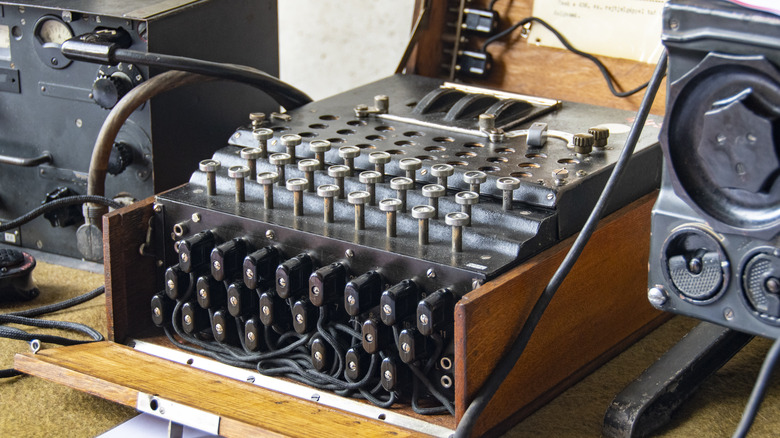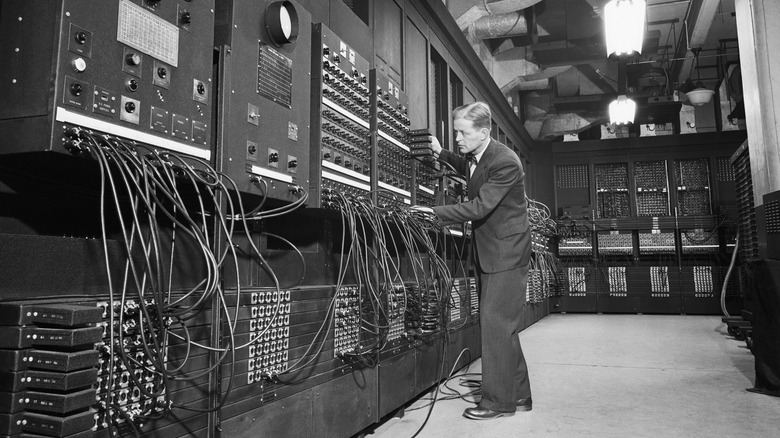How England Cracked The German Code Machine And Helped Win World War II For The Allies
Before we all had what are essentially little powerful computers in our pockets at the ready to solve any problem via search engines and AI, analog machines combined with pen-and-paper math was the go-to. There was little to no computing power around the time of World War II, except for devices like Colossus and Bombe, used by the British military for codebreaking, and the Electronic Numerical Integrator and Computer (ENIAC), used by the U.S. for general-purpose calculations. Smart people like the British mathematician Alan Turing were the brains behind these early iterations of computers, playing a key role in accelerating computer technology during World War II.
The Germans had their own encryption device called the Enigma, and it was used for creating powerful codes, much to the chagrin of the Allies. The Nazis used the Enigma to create codes transmitted across radio messages between military units and naval vessels. The Allied forces knew they had to act fast with counter-intelligence and raw brain power to reverse-engineer the Enigma, lest they lose their footing in the technological war. With mathematicians like Turing on their side, however, they had a fighting chance. Ultimately, capturing one of the Enigma machines would prove to be a windfall and the literal key to unlocking the Nazi codes. Here, we will explore this critical part of the war, in which the Allies raced to reverse-engineer and capture the lauded cipher device.
The Allies race to break the German code
In the early 1930s, as the world was slowly creeping toward a full-blown conflict, Polish mathematicians were already working on cracking the Enigma code. Led by Marian Rejewski, the Poles were able to reverse-engineer the wiring of the Enigma rotors, which was a significant hurdle given the complexity of the cipher device's rotary setup. By 1938, the Poles were able to build their own Enigma replica. Their machine was called the Bomba (the Polish word for a specific ice cream), but it only saw use until 1940 when the Germans switched up their code procedures. However, before being invaded by the German army, Polish teams were able to share their findings with French and British intelligence units, helping the Allies gain a leg up before the war would fully engulf them as well.
With Turing being used extensively to further advance progress on the Enigma situation, he, along with Gordon Welchman, developed the Bombe machine. This rudimentary computer, if you could call it that, was able to exploit some weaknesses in the Enigma and, with further development, was deciphering upwards of 84,000 messages per month by 1943.
However, it was a game of cat-and-mouse, as the Germans would often change the Enigma settings. Eventually, they even introduced a fourth rotor for more complexity. Thankfully, the British Royal Navy was able to capture several Enigma machines, in addition to their corresponding codebooks, helping them to stay on top of counterintelligence efforts.
The Enigma's legacy lasted far after World War II
With a grasp of the Enigma code, the Allies were able to use their findings to decode and understand Germany's plans and communications in advance of the Battle of the Atlantic, as well as for D-Day preparations. This helped to change the course of the war in favor of the Allies and is thought to have shortened the duration of the war.
While the Enigma was the bane of the Allies' existence for years, it did — in an unintended way — help to advance modern technology. As they say, necessity is the mother of invention, and the war in general pushed engineers to develop new advancements in technology, including some notorious WWII weapons. Some of these advancements were used for good, while others ended up being some of the worst military equipment of World War II.
The bottom line is that the incredible work of people like Turing and Rejewski led directly to rapid advancements in computers and programming. The shift from analog to digital computing would soon take over, leading to a new arms race of microchips and software. Turing's computability as a theory laid the foundation for modern computing tasks in the context of complex problem solving and number crunching. All of this, in turn, led to a more efficient society, where modern computers became irreplaceable.


